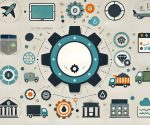Big data analytics examples are the practical uses of enormous volumes of data that help businesses and organizations make informed decisions, enhance services, and expand their business. These can vary according to industries like healthcare, banking, e-commerce, education, etc. Data science tools allow companies to forecast customer actions, prevent fraud, enhance product quality, and customize user experience. In this article, we’ll look at what Big Data Analytics is and its real-world use cases, how it works, and what the 3 Vs of Big Data mean.
What is Big Data Analytics?
Big data analytics is a system of different tools for managing large data. This data can originate from websites, social media, mobile apps, sensors, or online shopping. Big Data Analytics is the primary one that leads to faster and smarter decision-making for organizations. It transforms raw data into actions that increase efficiency, service, and profits.
With the emergence of Big Data, organizations now use specialized software and machine learning to store and analyze a large volume of data using advanced algorithms. Data science, this is the process of gathering, storing, cleaning, analyzing, and visualizing data. Big Data Analytics is used by businesses to understand customer needs, manage risks, prevent fraud, and predict future events. This process is essential for digital growth in each industry.
Big Data Analytics Examples
We see and use big data analytics examples from every industry on a daily basis. These examples demonstrate how big data helps work go faster, decisions become better and customers become happier.
Healthcare Industry
Healthcare big data has allowed doctors and hospitals to improve care and save lives. Predictive diagnosis is used in hospitals to detect early disease risks and initiate treatment timely. Doctors keep patient history with electronic health records (EHRs) and provide more personalized care. Real-time data also helps hospitals better manage staff, beds, and medical supplies. For example, In India, Apollo Hospitals uses the power of data analytics to predict heart disease, sending alerts to doctors for a quick response, leading to improved patient safety.
Banking and Finance
The banking & finance domain typically employs big data to facilitate safer and client-oriented services. Banks deploy fraud detection systems to examine transactions and prevent fraud as it is occurring. Through spending habits, they create customer profiles to provide customized services. With credit scoring, banks assess the risk before they lend. By implementing Big Data tools, HDFC Bank has benefited by preventing fraud at an early stage and personalizing credit card offers based on customer behavior.
E-commerce and Retail
To improve customer experience and sales, e-commerce websites and retail outlets implement Big Data. The product recommendation system recommends items based on previous searches and purchases. Companies even mine customer reviews and social media to unearth criticism and enhance services. With real-time sales and stock-level data, inventory management is made easier. For example, If you shopped on Flipkart, Big Data custom made deals and offers for you depending on your shopping history.
Education
The biggest data in education allows schools and colleges to make learning a lot more effective. Teachers and administrators monitor student performance and offer assistance in weak spots. For almost a decade, colleges have used analytics to predict dropouts and keep students on track. Data also allow to design of better courses by showing which content works better. Example: BYJU uses Big data to provide students with customized learning paths that suit their progress and requirements.
Transportation and Logistics
Regarding transportation, Big Data helps us travel better and deliver faster. Companies track traffic conditions to determine the speediest routes, which can reduce fuel and time waste. Fleet management systems track the health and performance of vehicles. Airlines and delivery services have forecast delays with weather and road data. For example, Indian Railways utilizes big data to monitor train delays, optimize schedules, and enhance passenger convenience.
Agriculture
Applied to optimize crop growth and minimize risks for farmers, crop prediction tools inform farmers when to plant or harvest. Soil sensors survey the state of the soil to provide updates that affect crop yield. Weather forecasts warn farmers of storms or droughts. For instance, IFFCO Kisan is providing Indian farmers with data-driven insights to boost harvests and help protect crops from adverse weather using its app
3 Vs of Big Data
Explain the complexities of Big Data in comparison to normal data. Standardized forms Vs of Big Data The V in each case refers to a particular challenge. These 3 Vs of Big Data together make analytics powerful yet complex. Tools like Hadoop, Spark, and NoSQL manage them.
Volume
Big data is, data a massive amount of data generated every single day. These datasets are difficult to work with on traditional databases and analysis tools. Potential solutions to big data analytics face processing level: Big data analytics solutions are manufactured to manage and determine these huge volumes of information easily.
As its name already suggests, the first and most defining feature of big data is its high volume. It is defined as the huge amount of data generated from multiple sources and devices on an ongoing basis and available for collection.
Velocity
Another key consideration is the pace of data generation and accumulation. The growing demand for real-time data streams from all sorts of data sources makes it important for businesses to quickly analyze and respond to information. With Big Data Analytics, organizations can make real-time or near-real-time decisions.
The speed of data generation is called big data velocity. In the world today, data are often created in real-time, or, near real time, and thus it needs to be processed, accessed, and analyzed in that same timeframe in order for it to make any and all meaningful impact.
Variety
There can be structured, semi-structured, and un-structured forms of data. Everything from text to images to videos and everything in between. Big data analytics tools can manage this array of data types, offering a comprehensive perspective and revealing insights that traditional analysis methods may overlook.
Data is heterogeneous so it can be from very different sources, structured or unstructured, or semi-structured. Structured data (think spreadsheets or relational databases) that used to make up the bulk of the data set today is now augmented by data that can’t be organized the same way, like text, images, audio, video files, or semi-structured formats like sensor data that don’t fit into a set data schema.
How Does Big Data Work?
To benefit, we should understand it first how big data works. From data collection to decision-making, it has multiple steps. The core principle behind big data is that if you have access to a multitude of data points about something, you are better equipped to derive insights that will inform decisions, identify pathways for growth, and optimize your business model. There are three main actions in making big data work:
- Integration: Big data has terabytes, and maybe even petabytes, of raw data from numerous sources and should be ingested, processed, and converted to a format that business users and analysts can use to begin analysis.
- Management: Where does the data reside in big storage in the cloud, on-premises, or both. Data needs to be saved in the format you need. It also must be processed and made accessible in real time. More and more companies have been migrating to cloud solutions leveraging infinite compute and scalability.
- Big picture: Analysis is the end of the line in big data if you aren’t going to analyze your data and take action, then the investment won’t be worth it. This is where data visualization transforms data into the information, alignment, focus and insights that can be communicated throughout the business. This involves utilizing tools to generate data visualizations such as charts, graphs, and dashboards.
Relevance to ACCA Syllabus
The paper explores the relevance of big data analytics to the Strategic Business Leader (SBL) and Advanced Performance Management (APM) papers within the ACCA qualification. Big data in organizations is used for fraud detection, financial forecasting, risk management, and performance measurement examples in real life. Students must get accustomed to a few efficient examples of organizations applying big data in fraud detection, financial forecasting, risk management, and performance measurement. Use cases in practice guide evaluation of data-driven decisions’ impact on ethical business leadership and control systems.
Big Data Analytics Examples ACCA Questions
Q1: Which is a real-world example of big data used in company audits?
A) Continuous monitoring of transactions to detect fraud patterns
B) Handwritten ledger matching
C) Filing paper-based tax returns
D) Manual counting of receipts
Ans: A) Continuous monitoring of transactions to detect fraud patterns
Q2: How do companies use Big Data in budgeting?
A) To analyze trends and adjust forecasts in real time
B) To print static annual reports
C) To approve only fixed costs
D) To allocate budgets based on last year’s figures
Ans: A) To analyze trends and adjust forecasts in real time
Q3: What is an example of Big Data usage in performance evaluation?
A) Real-time dashboards tracking KPIs from multiple departments
B) Annual verbal performance reviews
C) Paper attendance reports
D) Month-end summary charts only
Ans: A) Real-time dashboards tracking KPIs from multiple departments
Q4: In financial risk management, a common Big Data application is:
A) Predicting credit risk using customer transaction history
B) Writing checks for expenses
C) Manual file auditing
D) Paper invoice filing
Ans: A) Predicting credit risk using customer transaction history
Q5: What tool is often paired with Big Data for visualizing results?
A) Tableau or Power BI dashboards
B) Excel formulas only
C) Printed reports
D) Paper charts
Ans: A) Tableau or Power BI dashboards
Relevance to US CMA Syllabus
In US CMA syllabus, examples of Big Data are inflected into Performance Management, Strategic Planning, and Financial Statement Analysis. CMAs have also faced a challenge in interpreting how businesses have applied Big Data to analyze costs, achieve operational efficiency, and track customers’ profitability to improve long-term performance and strategy.
Big Data Analytics Examples CMA Questions
Q1: What is an example of Big Data use in cost management?
A) Identifying high-cost activities using real-time sensor data
B) Estimating cost manually
C) Using static expense logs
D) Filing physical invoices
Ans: A) Identifying high-cost activities using real-time sensor data
Q2: Which of the following illustrates Big Data in customer analysis?
A) Segmenting customers by purchase behavior for pricing strategies
B) Mailing monthly offers manually
C) Using spreadsheets without trends
D) Customer feedback on paper forms
Ans: A) Segmenting customers by purchase behavior for pricing strategies
Q3: A retail business uses Big Data to:
A) Forecast demand using foot traffic and weather data
B) Design paper brochures
C) Update product prices yearly
D) Print coupons manually
Ans: A) Forecast demand using foot traffic and weather data
Q4: How can Big Data assist in variance analysis?
A) By automatically identifying causes of variances using trend analytics
B) By recording data in ledgers
C) By ignoring root causes
D) By estimating based on memory
Ans: A) By automatically identifying causes of variances using trend analytics
Q5: What technology supports Big Data processing in finance departments?
A) Cloud-based ERP systems
B) Manual payroll registers
C) Fax machines
D) Paper cost sheets
Ans: A) Cloud-based ERP systems
Relevance to US CPA Syllabus
Big Data Analytics is becoming increasingly important in the Audit, Attestation (AUD), and Business Environment & Concepts (BEC) sections of the US CPA syllabus. The CPAs must know real examples to understand how Big Data assists audit sampling, fraud detection, compliance monitoring, and optimization of audit efficiency using automation and data mining.
Big Data Analytics Examples CPA Questions
Q1: What is a common use of Big Data in public accounting firms?
A) Risk-based audit planning using client transaction data
B) Typing audit reports by hand
C) Creating audit programs from scratch
D) Auditing only through interviews
Ans: A) Risk-based audit planning using client transaction data
Q2: In compliance monitoring, Big Data helps by:
A) Automatically flagging regulatory breaches from transaction data
B) Reading policy books
C) Printing laws manually
D) Collecting manual statements
Ans: A) Automatically flagging regulatory breaches from transaction data
Q3: What is a fraud detection example using Big Data?
A) Identifying unusual spending patterns across accounts
B) Verifying paper receipts
C) Counting cash balances manually
D) Checking audit logs by hand
Ans: A) Identifying unusual spending patterns across accounts
Q4: How does Big Data support internal control evaluation?
A) Tracking high-volume transactions for irregularities in real time
B) Rewriting company policies
C) Checking passwords
D) Filing HR documents
Ans: A) Tracking high-volume transactions for irregularities in real time
Q5: What platform is often used for Big Data audit analytics?
A) ACL or IDEA
B) MS Word
C) Adobe PDF
D) PowerPoint
Ans: A) ACL or IDEA
Relevance to CFA Syllabus
Examples of Big Data are shown in the CFA curriculum in Quantitative Methods, Portfolio Management, and Financial Reporting & Analysis. Candidates studying for the CFA should be familiar with the role of Big Data in market sentiment analysis, algorithmic trading, alternative data evaluation, and portfolio risk management to make better investment decisions.
Big Data Analytics Examples CFA Questions
Q1: Which is a Big Data example in investment management?
A) Using satellite imagery to estimate retail store performance
B) Reading printed news clippings
C) Relying only on analyst opinions
D) Skipping quarterly reports
Ans: A) Using satellite imagery to estimate retail store performance
Q2: How is social media used in Big Data for finance?
A) To analyze investor sentiment for market movement predictions
B) To chat with clients
C) To post updates only
D) To review firm branding
Ans: A) To analyze investor sentiment for market movement predictions
Q3: Which Big Data technique supports trading decisions?
A) Algorithmic models built from large, real-time datasets
B) Manual charting
C) Broker interviews
D) Quarterly press releases
Ans: A) Algorithmic models built from large, real-time datasets
Q4: What alternative data source is used in Big Data analytics for CFA-level investment?
A) Credit card spending trends across sectors
B) Office supply orders
C) Employee schedules
D) Corporate logos
Ans: A) Credit card spending trends across sectors
Q5: Which tool is commonly used in Big Data visualization for investment firms?
A) Python with Matplotlib or Seaborn
B) PowerPoint only
C) Printed spreadsheets
D) CRM dashboards
Ans: A) Python with Matplotlib or Seaborn


